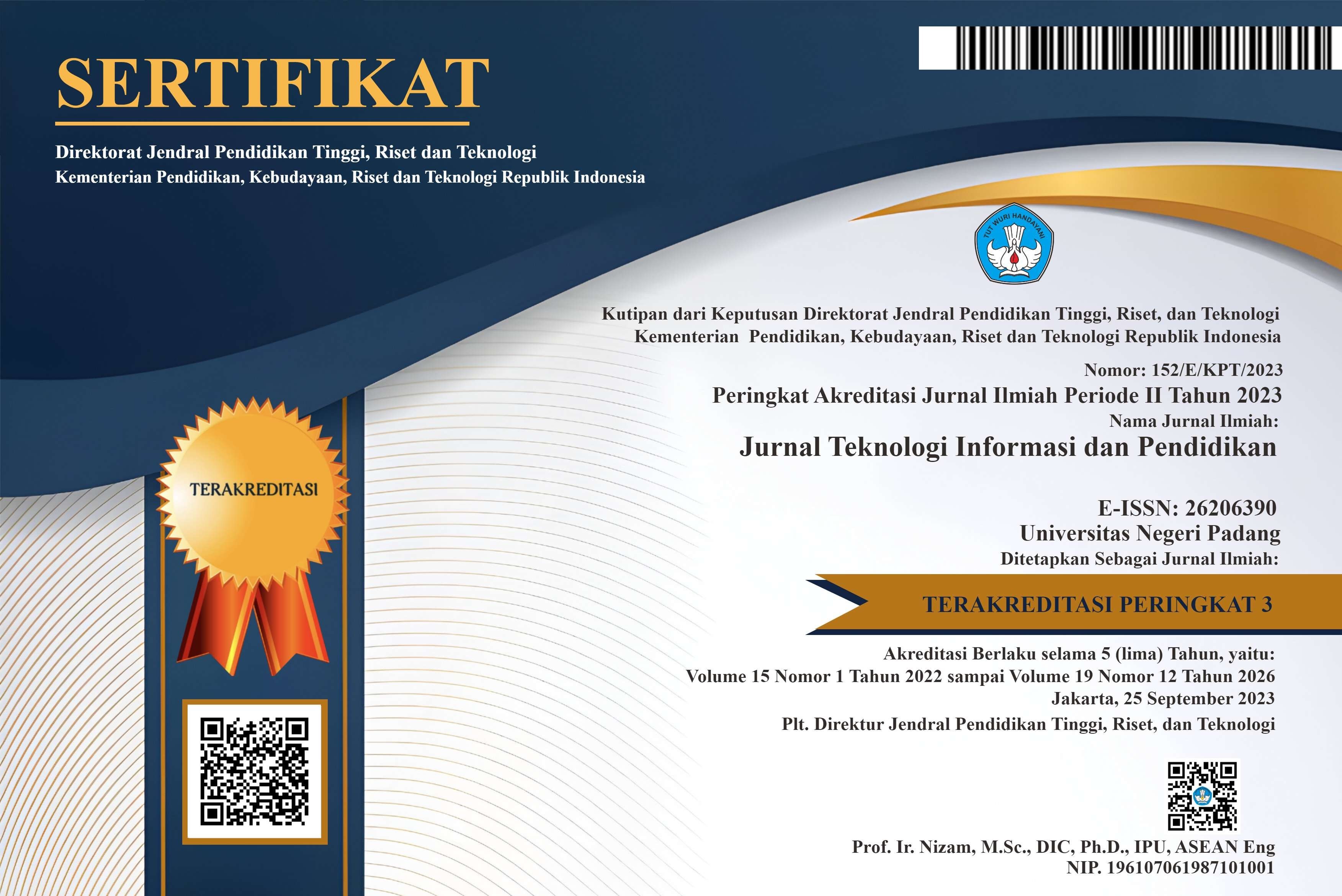Measurement of Technology Acceptance Model (TAM) in Using E-Learning in Higher Education
DOI:
https://doi.org/10.24036/jtip.v14i2.471Keywords:
E-learning, Learning Management System, Technology Acceptance Model, RegresiAbstract
Information and Communication Technology (ICT) growth triggers various educational institutions, especially universities, to use technology in their learning. The learning model with ICT is known as e-learning which is designed using a Learning Management System (LMS). Ahmad Dahlan University (UAD) has been using e-learning since 2009. Currently, an e-learning system is very much needed in the online learning process. The UAD e-learning development team developed a new e-learning system to overcome distance education during the pandemic. This study was carried out to measure TAM in the use of UAD's new e-learning. The factors used are based on previous research using two primary factors from TAM, namely perceived usefulness and perceived ease of use by adding other aspects (1) instructor characteristic, (2) habit, (3) computer self-efficacy, and (4) system quality. The number of samples was determined using the slovin method with the results of 86 people, and the technique of deciding respondents was using purposive sampling. The data processing method in this study was carried out using the SPSS 20 application. The analysis results showed that habit, computer self-efficacy, system quality, and perceived ease of use significantly correlated with perceived usefulness. In contrast, instructor characteristics had no significant relationship with perceived usefulness. The immense contribution of the influence of instructor characteristic and habit factors on perceived usefulness simultaneously is 45.8%, for computer self-efficacy and system quality factors on perceived ease of use are 41.3% and for perceived ease of use factors on perceived usefulness is other variables influence 33, 2% and the rest.
References
H. H. Batubara, “Buku Teknologi Informasi dan Komunikasi.” .
G. P. Riyanto, “Jumlah Pengguna Internet Indonesia 2021 Tembus 202 Juta.” 2021.
G. Ganefri, B. R. Fajri, F. Ranuharja, F. Prasetya, R. Fadillah, and F. Firdaus, “MINI SERVER LENTERA SEBAGAI ALTERNATIF PEMBELAJARAN DIGITAL DI DAERAH 3T,” J. Teknol. Inf. dan Pendidik., 2019.
Hartley Darin E, “Selling E-Learning,” Am. Soc. Train. Dev. New York, 2001.
S. E. Yulianto, “Pengaruh Persepsi Kemudahan Dan Persepsi Kemanfaatan Terhadap Pemanfaatan E-Learning Dengan Model TAM di,” JBTI, 2011.
Ratri Saras Mareta, “Analisis Faktor-Faktor Yang Memengaruhi Penggunaan E-Learning Moodle Oleh Guru Smk Negeri 2 Yogyakarta Dengan Pendekatan Technology Acceptance Model (Tam),” Skripsi, 2016.
I. Taufik, “Penggunaan E-learning UAD,” in Hasil awancara Pribadi, 2020.
Sulisworo Dwi and Dkk, “Online learning implementation during COVID-19 mitigation in indonesia: Measuring the lecturers’ technology readiness,” Int. J. Adv. Sci. Technol., 2020.
Amilia Sunan, “Kesiapan Usaha Mikro Kecil dan Menengah (UMKM) Menerapkan Standar Akutansi Keuangan Entitas Mikro Kecil dan Menengah (SAK EMKM),” Skripsi, 2020.
Handayani Wahyu Prabawati Putri and H. Mugi, “APLIKASI TECHNOLOGY ACCEPTANCE MODEL (TAM) PADA KOMPUTERISASI KEGIATAN PERTANAHAN,” J. Econ., 2016.
A. U. Warman and H. Ramlah, “PERSEPSI SISWA TERHADAP FAKTOR-FAKTOR YANG MENYUMBANG PADA PENERIMAAN PEMBELAJARAN ONLINE DI UNIVERSITAS TERBUKA,” J. Rekayasa Teknol. Nusa Putra, 2019.
F. D. Davis, “Perceived usefulness, perceived ease of use, and user acceptance of information technology,” MIS Q. Manag. Inf. Syst., 1989.
J. Abramson, M. Dawson, and J. Stevens, “An Examination of the Prior Use of E-Learning Within an Extended Technology Acceptance Model and the Factors That Influence the Behavioral Intention of Users to Use M-Learning,” SAGE Open, vol. 5, no. 4, 2015.
R. Ibrahim, N. S. Leng, R. C. M. Yusoff, G. N. Samy, S. Masrom, and Z. I. Rizman, “E-learning acceptance based on technology acceptance model (TAM),” J. Fundam. Appl. Sci., 2018.
H. Rafique, A. O. Almagrabi, A. Shamim, F. Anwar, and A. K. Bashir, “Investigating the Acceptance of Mobile Library Applications with an Extended Technology Acceptance Model (TAM),” Comput. Educ., 2020.
M. R. Rosly and F. Khalid, “Evaluation of the ‘e-Daftar’ System Using the Technology Acceptance Model (TAM),” Creat. Educ., vol. 09, no. 05, pp. 675–686, 2018.
C. Liao, P. Palvia, and H. N. Lin, “The roles of habit and web site quality in e-commerce,” Int. J. Inf. Manage., vol. 26, no. 6, pp. 469–483, 2006.
V. Venkatesh, J. Y. L. Tho, and XinXu, “Consumer Acceptance and Use of Information Technology: Extending the Unified Theory of Acceptance and Use of Technology,” Manag. Inf. Syst. Res. Cent., vol. 36, no. 1, pp. 157–178, 2012.
M. Hubert, M. Blut, C. Brock, C. Backhaus, and T. Eberhardt, “Acceptance of Smartphone-Based Mobile Shopping: Mobile Benefits, Customer Characteristics, Perceived Risks, and the Impact of Application Context,” Psychol. Mark., vol. 34, no. 2, pp. 175–194, 2017.
H. Jeong, “An investigation of user perceptions and behavioral intentions towards the e-library,” Libr. Collect. Acquis. Tech. Serv., 2011.
Y. M. Yusoff, Z. Muhammad, M. S. M. Zahari, E. S. Pasah, and E. Robert, “Individual Differences, Perceived Ease of Use, and Perceived Usefulness,” Comput. Inf. Sci., vol. 2, no. 1, pp. 2–9, 2009.
Bhasarie Herald Anwar Dkk, “Analisis Faktor-Faktor yang Memengaruhi Penerimaan Teknologi Menggunakan Kuesioner Technology Acceptance Model ( TAM ) pada E- Learning Google Classroom di SMK Negeri 2 Kupang,” J. Pengemb. Teknol. Inf. dan Ilmu Komput., 2021.
W. C. Poon, K. L. T. Low, and D. G. F. Yong, “A study of Web-based learning (WBL) environment in Malaysia,” Int. J. Educ. Manag., vol. 18, no. 6, pp. 374–385, 2004.















.png)














